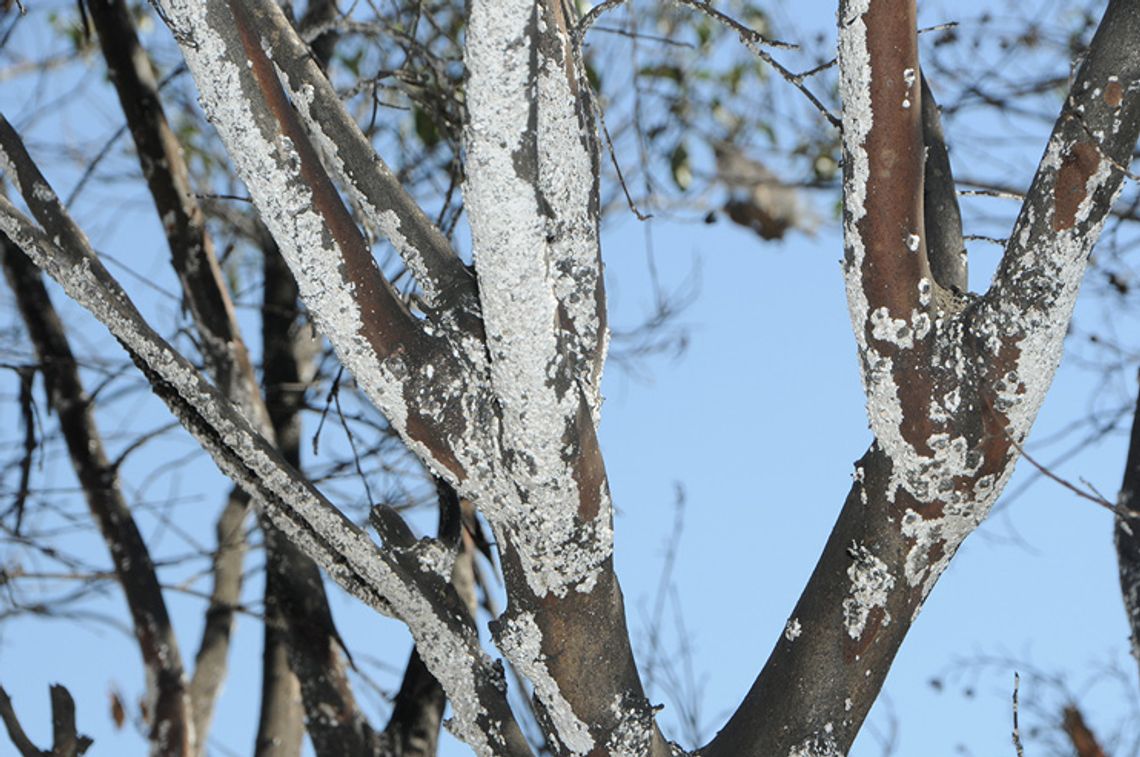Crape Myrtles are one of the most popular landscape plants in the South. Traditionally crape myrtles have been free of serious disease and insect pests, but that situation changed with the arrival of Crape Myrtle Bark Scale(CMBS).
CMBS is a serious new threat to southern crape myrtles. It threatens to turn what has historically been a beautiful, low-maintenance landscape tree into an unsightly, high-maintenance landscape tree. The nonnative scale was first detected in the United States in Texas in 2004 and was first found in Mississippi in the spring of 2004. It is now well established in several counties in Mississippi, including Rankin County. We need to know how to identify and control CMBS to help slow its spread and reduce its impact.
There are few natural enemies here in the United States, and this allows CMBS to build to unusually high numbers on infested plants. It is not unusual for heavily infested plants to have branches and twigs that are completely encrusted with scale. The nymphs produce large quantities of honeydew, and this results in heavy accumulations of sooty mold on the leaves, twigs, and trunks of infested plants, as well as on nearby low-growing plants and surrounding grass and mulch. The end result is a crape myrtle that is black and ugly (which is due to heavy sooty mold accumulation) and produces fewer and smaller blooms. Crape myrtles heavily infested with CMBS soon become a landscape eyesore. Effective treatments are available, but they are costly and do not provide 100 percent control. Treatments must be reapplied each year.
Sooty mold alone is not a definite indication of CMBS, but if you also find white, felt-covered scales that bleed pink when punctured, you can be certain you have crape myrtle bark scale. Heavy infestations can also cause trees to be covered with black sooty mold. Any Crape Myrtle that is covered with sooty mold, should be carefully examined for CMBS. Trees can have heavy infestations of aphids and CMBS. Aphids will feed only on the leaves, CMBS will feed mainly on the twigs, branches, and trunk, and rarely on the leaves.
Heavy infestations of CMBS cause crape myrtles to be very unsightly. Simply ignoring and living with the problem may not be an acceptable option for most homeowners and landscape managers. Control options for CNBS fall into our major categories; Exclusion, plant selection, plant destruction, and insecticide treatment.
The simplest and most effective defense against CMBS is to avoid buying and planting infested crape myrtles. Work closely with the nursery where the plants are purchased to be sure plants are free of crape myrtle bark scale.
Because of their unique beauty and toughness, crape myrtles are widely used in southern landscapes. Now because of CMBS, landscape planners are encouraged to consider alternative species in the landscapes to increase plant diversity. This will help mitigate the risks and adverse consequences of having to deal with heavy CMBS infestations.
The are times when total plant destruction may be the appropriate means of dealing with a CMBS infestation. An example would be when there are just a few infected plants and there is reason to believe that these may be the only infested plants in the landscape, community, city or region. In this case, it would be best to destroy these plants before the disease can spread.
This pest is so new that control programs are still being developed. Treatments that have been the most effective are soil applied systemic insecticides containing the active ingredients imidacloprid, imidacloprid + clothianidin, or dinotefuran. Foliar sprays containing the insect growth regulator products pyriproxyfen or buprofezin are also available as sprays.
Some of these treatments are commercial products, and homeowners are encouraged to seek assistance from licensed commercial applicators to control CMBS, especially when treating larger trees. The cost of products for homeowners is considerably higher than for professional products. Homeowners with large numbers of trees to treat should consider getting bids from commercial applicators. The cost difference between treating trees yourself and hiring a commercial applicator to treat CMBS may not be as great as you think.
Source: Extension Publication 2938, Crape Myrtle Bark Scale Identification and Control


Comment
Comments